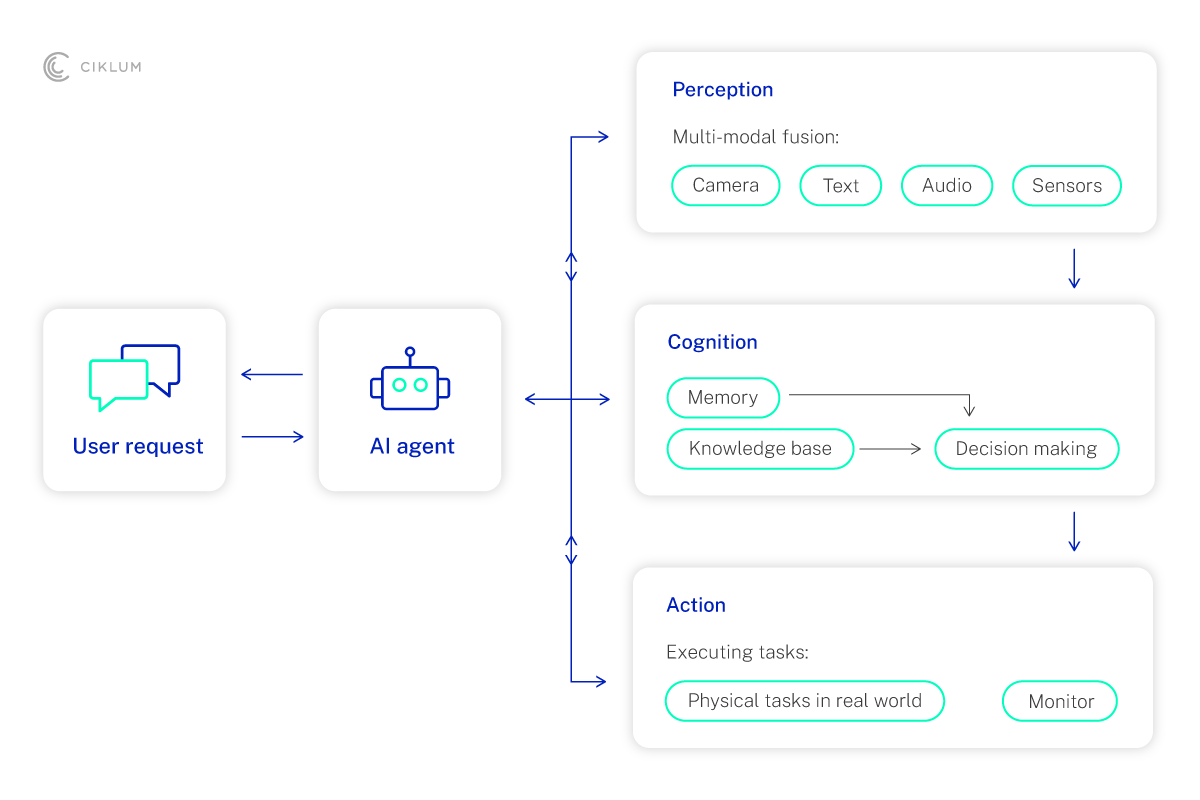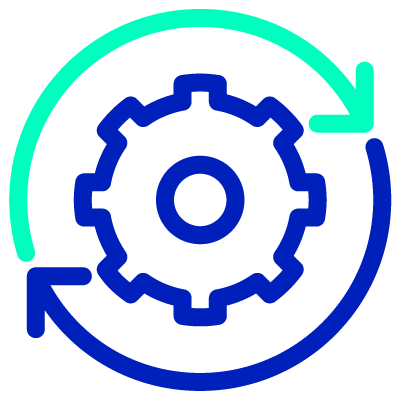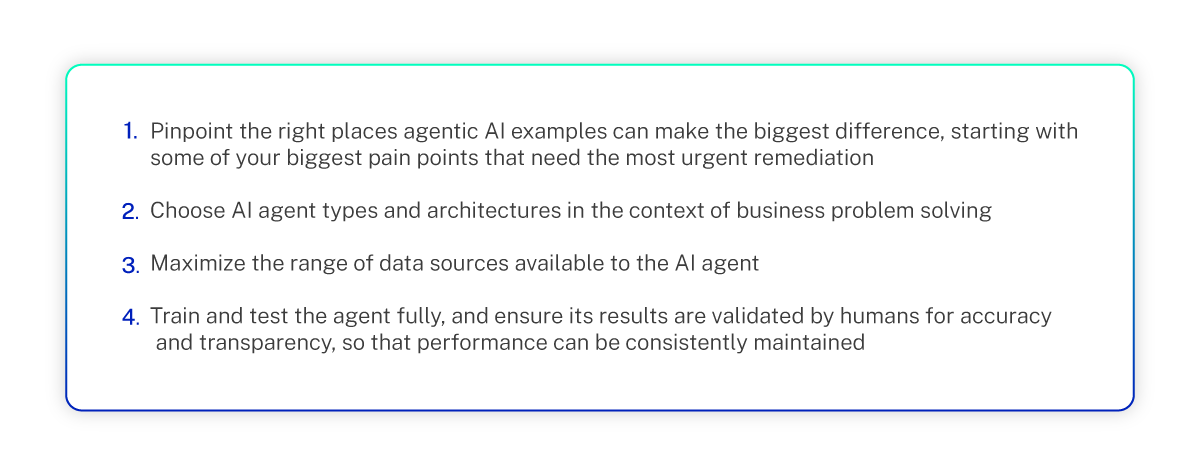- Key Takeaways
- What is Agentic AI?
- The Evolution of Agentic AI Systems
- What Are the Building Blocks of Agentic AI?
- Pros and Cons of Agentic AI
- Impact of Agentic AI on Enterprises
- Agentic AI as a New Framework for Enterprise
- How Agentic AI is Expanding Intrinsic and Collaborative Capabilities
- In Summary: The Future of Agentic AI and How You Can Maximize It
Key Takeaways
- Agentic AI is steadily progressing towards providing more versatile agents with cross-sector and collaborative capabilities.
- GenAI will persist in Agentic AI workflows, particularly where creative output is required.
- RegTech could highly influence the direction of Agentic AI innovations pertaining to data cloud solutions, reasoning engines and connectors.
One is agentic AI, which takes the principles of generative AI to the next level, expanding the involvement that AI can take in day-to-day work and reducing the amount of human input required to get the most out of the technology. This blog explores agentic AI, what it means for your organization, and how best to apply it now and in the future.
What is Agentic AI?

Good agentic AI solutions can make their own judgment calls, make decisions in context, and adjust objectives and workflows in real time as circumstances and situations evolve. They can move between different tasks and applications in a logical order to maximize the efficiency of processes, and can also understand and execute instructions given by humans in natural language as and when required. They can also autonomously navigate complex decision trees, and self-improve through reinforcement learning and continuous feedback looks.
The ability to take the bigger picture into account is the key area in which agentic AI differs from conventional AI platforms. Being able to leverage huge datasets, major computing power and large language models (LLMs) mean that agentic AI can plan out what it needs to do, then go and do it.
The Evolution of Agentic AI Systems
Agentic AI can be seen as the logical next step from the conversational AI platforms that have become commonplace in recent years. What used to be relatively simple chatbots, gradually expanded in functionality to handle requests and processes based on natural language and autonomous driven decision-making.Agentic models take this further by moving beyond ‘request and response’ processes and towards more complex systems that are based around actions and workflows, such as Large Action Models (LAMs). These differ from AI copilots in that they have much more autonomy and independence to make their own decisions, using their own understanding to make choices without needing input from human endeavor.
What Are the Building Blocks of Agentic AI?
An agentic AI architecture is typically made up of three core components, each of which makes its own valuable contribution:Perception: the integration of data from many different sources, in order to gain the most detailed understanding of the situation possible. This can include text, still images, video, audio, and even information from sensors gained from IoT devices.
Cognition: the processing of the information gained at the perception stage, in order to make the right decisions for workflows and processes. This is achieved through the use of deep learning models, and leveraging the results of previous experiences.
Action: using the cognitive decisions made to execute complex tasks and workflows, control algorithms to ensure precision, create feedback loops that can make dynamic adjustments as required, and even robotics where the actions required are physical rather than digital.

One of the reasons that agentic AI is so full of potential is the sheer breadth and diversity of the data stores it can make use of. This can include unstructured data, structured data, embeddings and vector stores, and even knowledge graphs. The fact that agentic AI can operate in both digital and physical contexts also expands the possibilities of real-world use cases for the technology.
Pros and Cons of Agentic AI
If deployed correctly and in the right places, the scale of the benefits that agentic AI can deliver is enormous, including:
 Efficiency:
Efficiency:
Being able to not only process vast amounts of data, but also make contextual decisions faster than humans, can make everyday workflows much quicker, more efficient and more accurate.
 Scalability:
Scalability:
Agentic AI platforms can deal with several different tasks and workflows at the same time, allowing them to take on the work of several people and multiplying productivity.
 Adaptability:
Adaptability:
As agentic AI can adapt to changing information and circumstances, and learn from new data provided to it, the processes it completes always remain relevant and optimized.
 Security:
Security:
That adaptability can also prove useful in a security context, when trying to identify and respond to new and emerging threats as quickly as possible, and with minimal impact to the organization.However, as with any type of AI, there are a number of practical and ethical challenges that need to be navigated along the way:
 Integration complexity:
Integration complexity:
Agentic AI represents such a big change compared to traditional AI deployments, that integrating it into existing process and infrastructure may require some complex adjustments to be made.
 Ethical issues:
Ethical issues:
The ability for AI to make strategic decisions autonomously will generate even more questions around ethical use of AI, transparency and regulatory compliance. Clarity in decision-making processes and the ability for AI systems to provide rationale for their actions, often referred to as “explainable AI”, is crucial in mitigating these issues and fostering trust among stakeholders.
 New security risks:
New security risks:
While agentic AI can be a force for good in security terms, it also has the potential to introduce new risks and vulnerabilities. If a system so comprehensive in its nature is compromised, and its decision-making abilities are impaired, then the knock-on impact on businesses could be severe.The good news is that none of those challenges are insurmountable, as long as the right safeguards are in place. We recommend explanations for AI decisions to establish accountability; human oversight and validation of the platform and its work; extensive testing to iron out any issues; and regular reviews of performance.
Impact of Agentic AI on Enterprises
There are also some indirect benefits that agentic AI can deliver for businesses - and it should be seen as a complement to the efforts of the human workforce, rather than as a replacement.For example, the ability for agentic AI to assume even more of the mundane workloads that staff face means they can devote a greater amount of time to value-adding work where human input is especially important. For example, HR onboarding and offboarding can be fully automated, as can repetitive IT processes such as resetting user passwords. Similarly, being able to automate real-time informed decision making and make adjustments on the fly can be instrumental in supporting fluid and flexible processes.
Fraud monitoring in finance is one such area where dynamic adaptability can be so important. Continuously monitoring activity to spot suspicious activity is within the domain of traditional AI, but agentic AI can also make decisions about which suspicious patterns to raise to staff for further investigation. The same principle applies in healthcare, where agentic AI can help clinicians make the right decisions about treatment, in situations where the fluctuating health of the patient means that they’re often aiming at a moving target.
Agentic AI as a New Framework for Enterprise
As is always the case with AI, the quality of the output is heavily defined by the quality of the input. In order for agentic AI to support more complex workflows, a number of components need to be put in place, above and beyond the basic prompts that would be used for traditional AI.
Agentic AI needs contextual memory of prior experiences and situations; the ability to combine different types of data such as text, audio, images and video; operational components that can execute the processes devised; the ability to set goals and workflows within the overarching objective; and safeguards around privacy, transparency and compliance.
With these in place, organizations can then investigate customization opportunities, such as models specialized for specific purposes, fine-tuning responses to be suitable for business environments, and connecting different data sources and knowledge bases.
How Agentic AI is Expanding Intrinsic and Collaborative Capabilities
Regarding integration challenges, some organizations are already packaging pre-trained models called NIMs (Neural Information Microservices) to enable different AI systems to interact smoothly. These are part of a broader vision underpinned by AI lifecycle platforms whose tools and libraries support data curation, training, evaluation and synthetic data generation among other capabilities.
However, while these developments highlight the trend of starting with AI agents built for ultra-specific tasks, the opposite is also happening. New partnerships are turning the microservice approach into more comprehensive offerings.
Improving AI Model Customization
The AI agent platforms mentioned above are transcending CRM (Customer Relationship Management) use cases and providing a multitude of sector-specific bots on the platform that will be able to collaborate and offer more versatile agent services. Some companies have already built tools like recruitment agents using these platforms.
Such agents scan applications, shortlist fitting candidates, notify recruiters, check availability and schedule interviews, making all the necessary calendar changes.
Fusing GenAI with AI agents
These agents also harness GenAI to produce relevant questions recruiters can use in the interviews. Accordingly, we could see more AI agents relying on GenAI for process steps that require creativity, whether it’s coming up with ideas from scratch or based on guiding data.
Forthcoming Agentic AI Improvements
One area that could gain more attention in 2025 is the engines that apply techniques like knowledge graphs and recursive trees to enable semantic understanding of the data handled.
Another area of focus will be RegTech, which refers to the tools that will be used to ensure that creations like Adecco’s recruitment agent remain compliant. RegTech providers could go beyond evaluating data protection capabilities and examine how easily these agents can be biased and influenced to deviate from would-be outcomes.
In Summary: The Future of Agentic AI and How You Can Maximize It
Agentic AI workflows will play a big part in the progress of AI over the next couple of years, and beyond. Businesses who can orchestrate workflows, harmonize analytic data and create connectors to legacy apps in the near future will gain a meaningful first-mover advantage. Whether it’s automating customer service over the phone, or taking care of loan application processing, the levels of efficiency, speed and accuracy that can be achieved are too great to ignore.But what can you do in practical terms to make the most of the impending agentic AI revolution? We recommend the following steps:
- Pinpoint the right places agentic AI examples can make the biggest difference, starting with some of your biggest pain points that need the most urgent remediation
- Choose AI agent types and architectures in the context of business problem solving
- Maximize the range of data sources available to the AI agent
- Train and test the agent fully, and ensure its results are validated by humans for accuracy and transparency, so that performance can be consistently maintained

Blogs



































